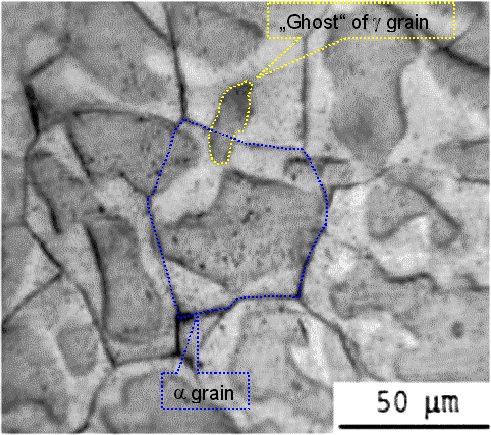| |
|
| |
Producing Ghosts the Simple Way. |
 |
In iron alloyed with about 0.2 % to 1.2 % phosphorous (P) most variants of defect etching come up with a peculiar structure termed a ghost
structure. If you have only an ideal iron - phosphorous alloy (without anything else) you will expect at room
temperature to see ferrite grains in an etched sample, separated by well-delineated grain boundaries. You will see that
- but there is more. As soon as you defocus a little, a second kind of structure appears: dark or bright "ghosts"
that are superimposed on the now slightly defocussed ferrite grain image. They look like grains - but there are no grain
boundaries! |
|
 |
Here is the picture
from the backbone once more. Now let's see how it came into being in somewhat more detail what has been already given in the backbone.
|
| | | |
| |
|
| | | |
|
 |
What you see are the "ghosts" of dead austenite grains. They existed at high temperature
and then disappeared completely, leaving only their ghosts back - in the form of phosphorous poor areas in the ferrite grains.
In many etchants these areas dissolve a little faster than those parts of the grain containing phosphorous. They are then
standing up like little mesas and become visible under the right conditions. They are best seen if you defocus your microscope
a little. The picture then is not as crisp as it could be - but you see the ghosts! |
 |
Why do we get such a structure? A picture says more than many words. The one below is different
from the one in the backbone; here we start at a higher temperature. Contemplate it and see if you can figure out what it
shows. |
| | |
|
| |
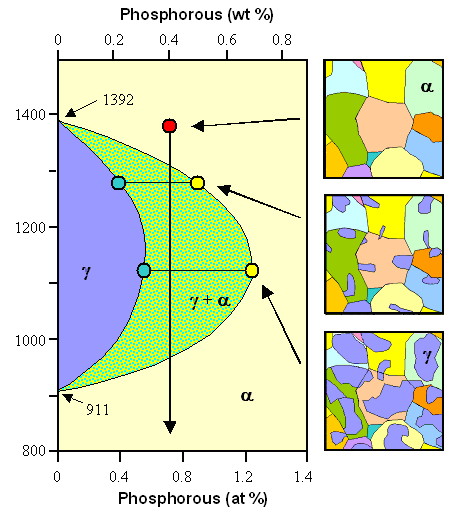 |
The development of a ghost structure in P-steel.
The blue regions symbolize austenite grains. |
|
| | | |
|
 |
We start with the red state point at high temperatures. We will
have a large-grained bcc ferrite crystal (a) with a bit of dissolved phosphorous - 0.72
% to be precise.
As the temperature goes down, we will eventually hit the a + g
region. That necessitates that fcc austenite (g) grains develop. Nucleation for the austenite
grains most likely starts at the grain boundaries between the ferrite grains. According to the phase diagram the g grains must be phosphorous-poor and the phosphorus needs to get out of the forming austenite.
At high temperatures the phosphorous has no big problem to diffuse into the a grains,
it will become enriched there.
As soon as the temperature falls below the value where the a
+ g region has its maximum extension, the g grains have
reached their maximum size. If the temperature keeps decreasing, they must now shrink. That's what the will do until they
eventually disappear completely after the state point left the a + g
region and we need to have pure ferrite once more.
The phosphorous concentration is supposed to equilibrate again,
and that's what it would do, if there would be sufficient
time. However, during the shrinking part and after the austenite has disappeared, it's getting colder and atomic movement
by diffusion slows down rapidly. Hardly ever will there be sufficient time for the phosphorous to "reclaim" the
former austenite grain regions and the phosphorous concentration in the regions of the former a
grains is still larger then in the rest of the steel.
If some etchant responds to that, you are now going to see ghosts.
The ferrite grains need not to have changed very much throughout the whole ordeal; they just gained some phosphorous relative
to the austenite and never gave all of that it back. |
 |
Here is what the structure of the picture in the backbone must have looked like at about 1100
oC (2012 oF) the temperature where the austenite grains are largest: |
| | | |
| |
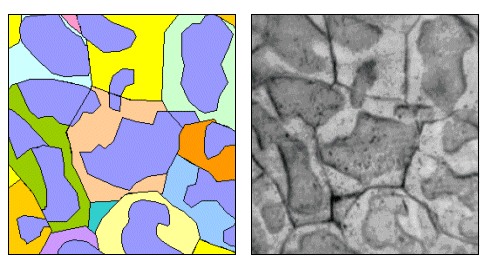 |
| Ferrite and austenite (Blue) at high temperatures (schematic) and the resulting ghost
structure seen in the microscope at room temperature |
|
| |
|
 |
In the example that structure defines the "ghosts" seen at room temperature. Of course, the austenite
grains at high temperatures have different crystal orientations, like the ferrite grains where this is symbolized by different
colors. They are shown in just one color to make them stand out.
When the austenite grain shrink, the ferrite forming
just keeps the orientation of the original a grain, and the final grain structure is more
or less identical to the starting one - except that the phosphorous is now distributed in an inhomogeneous way. |
 |
So, whenever you see a ghost structure, you know that you have phosphorous steel with phosphorous
concentrations somewhere between 0.5 % and 1,2 %?
Maybe. But it is not certain. Why not? Read on! |
| | . |
| |
Not All Ghosts are Equal |
 |
The nice ghost structure above is not the last word on phosphorous steel structure
for a variety of reasons. Here is the list:
- A lot of alloying elements are ferrite-stabilizers with a
phase diagram similar to that of phosphorous, known as "closed g-phase". There is, for example Silicon (Si), aluminium (Al), beryllium
(Be) titanium (Ti), vanadium (V), molybdenum (Mo) and chromium (Cr), and in particular arsenic (As). If the phase diagram
are similar, the structures will be similar, too. You must expect "ghosts" if you have some of those alloy elements
in your iron.
- You very rarely have pure P-steel. More likely it is P,C - steel or P,C,As - steel. And what happens then is not so
clear. There may or may not be ghosts.
- For phosphorous concentrations below about 0,4 % you have only the g-phase
for a while. Will this produce a ghost structure? If yes, what would it look like?
- Ghost structures rely on differences of the phosphorous concentration within one grain. This necessitates that the phosphorous
could diffuse enough to establish concentration differences at high temperatures but not enough to equilibrate these differences
during cooling. What we see ghostwise thus must depend on the thermal history to some extent.
- Indeed, one would expect that the ghost structure for one and the same piece of phosphoric steel would be different
if your holding temperature (= starting point) at the high temperature was above the
a + g region as in the figure above or
inside it as in the example in the backbone. I have shown
the same final structure for both cases but that is not realistic. In the example given here you would rather expect structures
similar to the ones shown below.
- The phase diagram predicts that most of the phosphorus should be found in iron-phosphide precipitates (Fe3P)
at room temperature. One the one hand, precipitation would remove the reason for ghost structures, on the other hand, it
starts at temperatures that might be too low for much to happen. What will you find in your specific sample that may contain
some other stuff like carbon or arsenic, and looks back to some specific thermal history?
Some of these points are discussed in the backbone so I will not
go through all of them here. |
|
 |
Here is a picture that shows ghosts in P,As - iron: |
| |
|
|
|
 |
| Ghosts from phosphorous and / or arsenic in old steel. |
| Source: Brook Abdua, Robert Gordon: Iron artifacts from the land of Kush; Journal of
Archaeological Science, Volume 31, Issue 7, July 2004, Pages 979–998 |
|
| |
|
| |
 |
The original picture caption says: "Longitudinal section of the
spear point 1,573b etched with nital and treated with Stead's reagent to show composition differences retained from the
a + g
phase field. Upon heating to 925 °C the g-phase that formed in the a-phase grain boundaries rejected phosphorus (and arsenic) into the
a-phase. The resulting composition gradients have been retained. Dark areas have low phosphorus
/ arsenic concentrations."
I added the arsenic but the paper made clear that
the authors were aware of having some arsenic in their steel. It can be seen quite nicely how the austenite grains nucleated
at the ferrite grain boundaries - some "ghosts" line a grain boundary like leaves on a branch. This is what one
would expect if one starts with pure ferrite, i.e. at a temperature above the a + g region.
What we learn is that some arsenic does not seem to
change the general "Ghosting" behavior, as one would expect. |
 |
Summing up points 1 and 2, the present knowledge is that all kind of mixes can
produce ghosts. The ghost picture by itself, however, cannot tell you what, exactly, you had in your steel. However, some
mixtures may not produce ghosts. That is in part also due to the observation that it
matters also how you cool down. |
|
 |
That is not a surprise. If you cool down quickly, the phosphorous has not much time for diffusing
and cannot get very far. It may make it out of the austenite but may not have enough time to spread out in the ferrite.
Then you must expect that there is some phosphorous enrichment at the interface ferrite - austenite. If you get ghosts at
all, the look more like blurry lines |
 |
If there is also carbon in your steel, you will form some pearlite upon cooling.
What you see later at room temperature might look like this: |
| | |
|
|
|
 |
| Ghosts around pearlite colonies - light microscope. |
|
| |
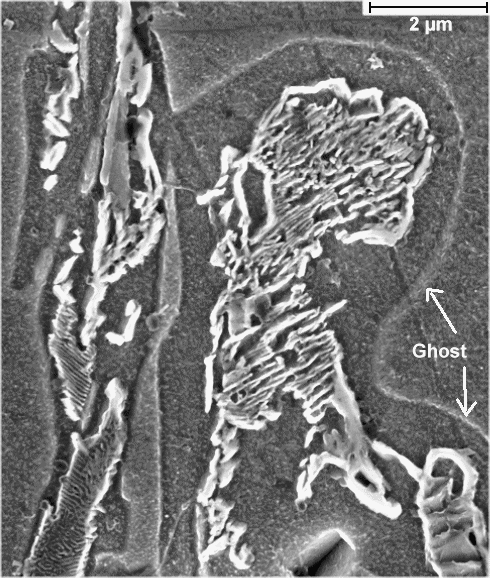 |
Ghosts around pearlite colonies - scanning electron microscope
Specimen from an unclassified Nydam sword fragment |
| Source: The picture was taken by one of the indispensable grad students (Jan-Hendrik Morjan in this case) working for me |
|
| |
| |
|
 |
You figure out exactly what has happened! Being a nice guy, I give you a hint:
"Pearlitic ghosting was a new structure discovered during this study. This
ghosting structure may be a clue into the relationship between phosphorus and carbon in archaeological iron. This was a
halo of ghosting seen around pearlite. The testing of this ghosting showed a depletion of phosphorus immediately adjacent
to grain boundary pearlite (figure 78). This ghosting structure could have been the result of the combination of phosphorus
segregation to the austenite grain boundaries and the formation of pearlite from the austenite within the low phosphorus
areas upon cooling." |
 |
If we have ancient phosphoric bloomery iron, we have slag inclusions. These inclusions
might change what you see. Here is a pictures that makes that very clear: |
| | |
|
| | |
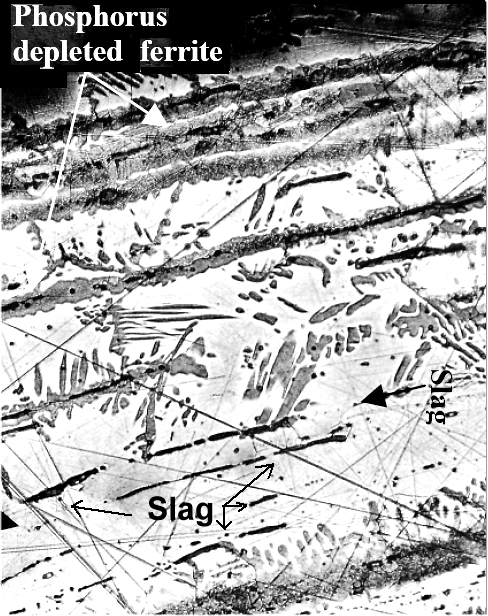 | Ghosts (grey areas) forming at slag inclusions
Armor piece, 16th - 17th century; Nital / Oberhoffer etch |
| Source: D. Vella , C. Degrigny, M. Grech, A. Williams: " Metallurgy of armour exhibited
at the Palace Armoury Valletta, Malta. Proceedings of Metal 2004, National Museum of Australia, Canberra (2004), p.
|
|
| |
| |
|
 |
Most of the austenite grains nucleated at slag inclusions, grew into the ferrite and disappeared
again, leaving only their ghosts behind. The ferrite grain boundaries are not visible; the straight lines are due to scratches
during (insufficient) polishing |
 |
Professional ghost busters came up with 5 different ghosts - but I won't go any
deeper into this. Suffice it to say that at present we go by the following two assumptions:
- If some etching process produces some ghosts, it is very likely that your steel contains phosphorous. It may contain
also some other stuff, notably carbon and possibly a bit of arsenic or only arsenic in rare cases.
- If some etching process does not produce some ghosts, chances are that your steel
does not contain phosphorous and / or the other stuff. But you cannot be sure. There
are known instances where ghost-free structures did contain phosphorous.
|
|
 |
To say it with Samantha R. Rubinson,
who has written a whole Ph.D. thesis (see below) and papers
related to this topic: The role and significance of phosphorus in iron is poorly understood. |
| |
| |
© H. Föll (Iron, Steel and Swords script)
